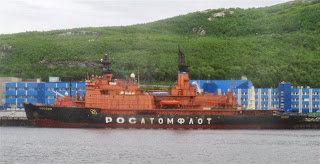Thursday – 27 June 2013 – Murmansk, Russia
Waking up after the two hour time change yesterday gave us a serious case of ship lag, but we were anxious to visit Arctic Russia. Murmansk is the home of the Northern Fleet of the Russian Navy and the base for the atomic powered ice breakers. Of great historical significance during WWII was that the Allies supplied the USSR with essential supplies using convoys from North America to this most northern of ice-free ports, usually during the long dark winters to avoid detection by the German forces.
The Gulf Stream provides a quite mild climate for 120 miles north of the Arctic Circle. Temperatures usually don't drop below +10 F degrees in winter or exceed 75 F or so in summer. It rains a lot in summer, but of course it is light out for all of June and July. The population at just over 300,000 is essentially half of that during the cold war, and the extensive ship yard along the estuary was eerily quiet during our nine hour port call.
Without holding $500 per person Russian visas, we were obliged to venture off the ship only on organized tours. We chose "City Views and Oceanarium". The guide, a native born low paid instructor at the teachers' college, one of the two universities here, had good English for someone not taught by a native English speaker. (We did see the technical maritime university, the other college, as we left the port.) Fishing is now the big industry here, she explained. Just about everyone in Murmansk is involved in fishing, processing, packing, or repairing fishing vessels. She said that this is a male dominated, laboring city, where education is held in low esteem, and as a result even doctors as well as teachers are paid very poorly. This is not my kind of place.
The architecture reflects the different stages of modern Russian history as the Germans leveled the town during WWII, but they never succeeded in occupying it. The Stalinist Socialist style is reflected in the green gem of the railway station (note the faded red star above the roof), the terminus of the 26 hour journey south to St. Petersburg, but the Stalinist apartment buildings built after the war are in serious decay. Khrushchev and Brezhnev era apartment buildings, also in serious decay, are surrounded by thousands of square miles of tundra.
Our tour consisted of the best that Murmansk could offer the tourist. We visited a bunch of monuments—the Soviets loved to build monuments including a gigantic WWII soldier with a little head but a really cool overcoat---and a little "Orthodox Cathedral". We discovered that the "Oceanarium" was not the research facility of Arctic wildlife we were led to believe but rather an endearing children's trained seal show. The creatures looked well fed and didn't appear abused, however, and the trainers seemed to really love their animals. The room did smell awful from all the fish. Go figure.
We returned to the ship via the amazingly conventional downtown with its two department stores and the normal assortment of regional company headquarters, including that of one of the cell phone companies. We cast off at 6pm under the watchful eye of the, uh, "port agent". This gentleman appeared to be writing notes on every tourist that left the ship. This is Russia, after all.
My conclusion after this short (but long enough) visit to Murmansk was not how nice or not nice this place is, but rather that a full service functional city does exist in the Arctic.










